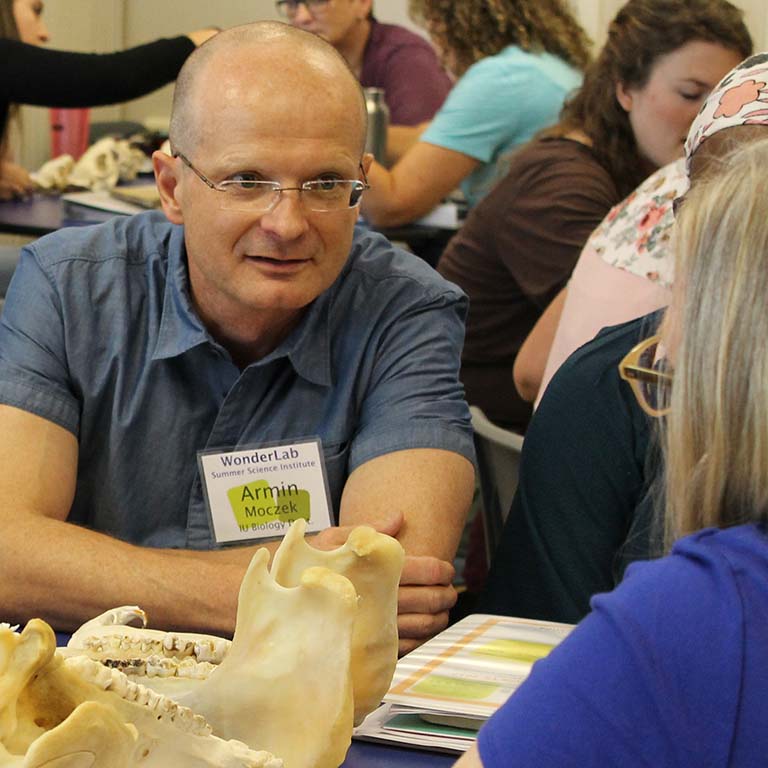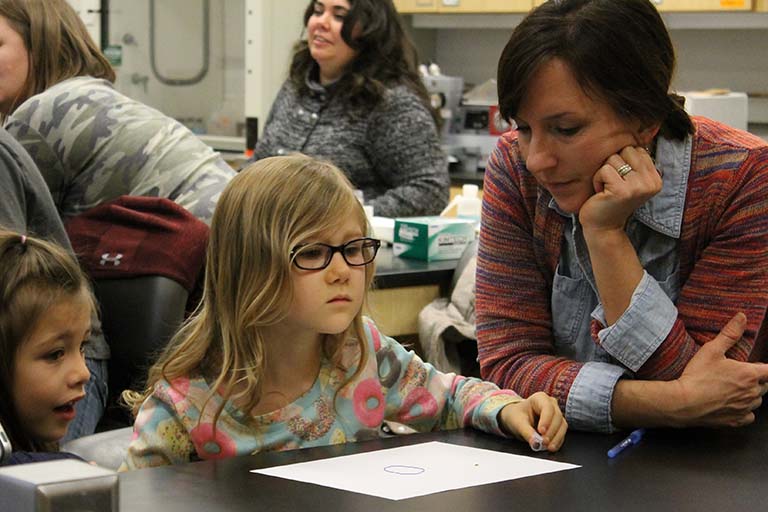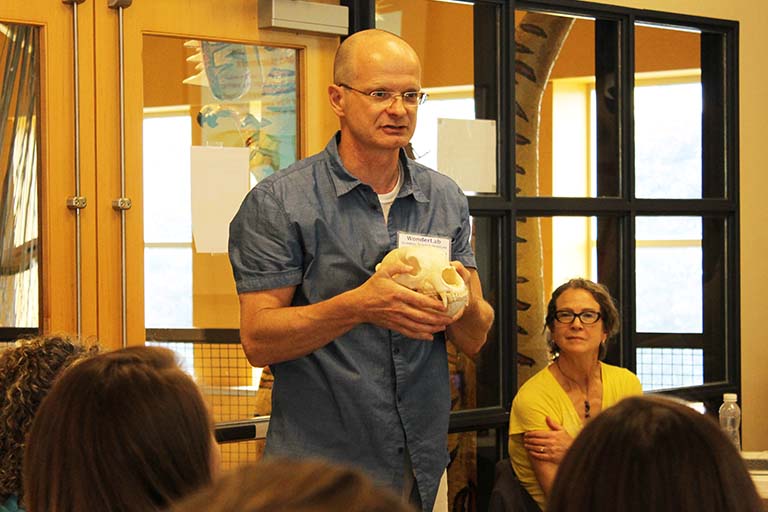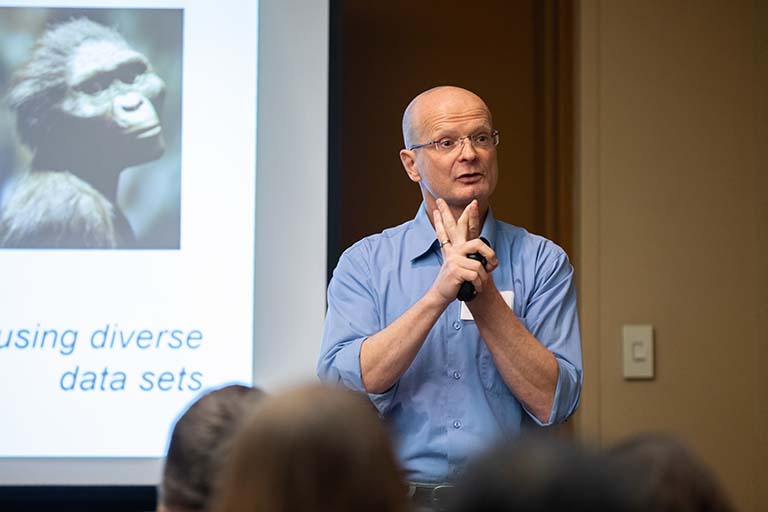In 2005 Karen Jepson-Innes (now executive director of WonderLab Museum of Science, Health, & Technology) and Armin Moczek (professor of biology) got together for the first time to brainstorm about developing a teacher-training workshop. The goal was to develop and present teaching modules that bring to life biology—and to do so in ways that support Indiana’s Academic Standards for Science. The first workshop was held in 2006; about 20 teachers participated, and all modules focused on insects, a group of organisms for which both Jepson-Innes and Moczek have great affection. And one module in particular, using trail-following behavior in termites, created immediate excitement among teachers because of the eye-catching opportunity it provided to model the scientific method. Fifteen years later the termite module is now widely used in local and regional schools, averaging approximately 50 classes every year.


This brings us to the present. Twenty workshops and over 400 participants later, Moczek has developed a dozen modules and expanded into content areas well beyond insects. What all modules share is utilizing eye-catching or otherwise captivating materials, from live insects to real mammal skulls to casts of fossil hominids. And each module puts students in the driver’s seat as they confront scientific evidence, probe its explanatory value, and reconcile conflicting observations. In the process, the learning of science, what we know, is connected to the practice of science, how come we know this, what are the limitations of our knowledge—dimensions that normally get lost in the classroom.
Where modules differ is in the increasing diversity of content areas they attack. Insects still play a big role, as in a module on insect life cycles and metamorphosis that fits particularly well with teaching standards for second grade. But other organisms have been added: one particularly successful module on the Evolutionary ecology of skulls and teeth utilizes 40+ mostly real skulls of diverse mammals to teach students how to distinguish basic feeding types, before introducing more complex concepts such as convergence (using marsupial skulls) and artificial selection (using diverse dog breeds). Another titled Reconstructing 6 million years of human evolution using diverse data sets uses high-end casts of modern human skulls and fossil hominids, alongside hands, feet, artefacts, and climate data to allow students to piece together an increasingly complex and nuanced understanding of their own evolutionary origins. Combined both modules have so far been taught over 400 times.

In all of this Moczek and Jepson-Innes try to make it easy for teachers to participate in workshops and adopt modules. Workshop participation is free and often comes with a stipend. Other funds cover expenses for substitute teachers. Moczek and his lab members assist teachers interested in trying out a module through school visits and by modelling module implementation in the classroom. All materials necessary to teach a module are provided for free. For some modules this is easy: Moczek cultivates termite colonies in his backyard for teachers to use. For others, it’s harder. Yet with help from funders such as the National Science Foundation and IU’s Ostrom Grants Program, Moczek and Jepson-Innes were able to duplicate all materials needed for the Mammal skulls and Human evolution modules, which now makes them loanable from both Moczek or WonderLab by request. Moczek also trained WonderLab staff in both modules so, if teachers prefer, students can experience the modules during a visit to WonderLab, with WonderLab staff running the show.
Last fall these efforts reached a new level. For years Moczek had been collaborating with Dr. Kirstin Milks, a science teacher at the local Bloomington High School South. Her expertise and lessons learned while piloting the Human evolution module in her classroom had helped tremendously in the development and fine tuning of this effort. Then, in 2019, Milks and Moczek were invited to present this module at the annual meeting of the National Association of Biology Teachers conference in Chicago. They made their presentation in a workshop attended by approximately fifty teachers from around the country, receiving overwhelmingly positive feedback and requests to share all this with a broader audience through publication. The corresponding manuscript is now in its initial stages, as are efforts to utilize existing 3D printing files to create classroom-ready, affordable skull replicas for any educator anywhere willing to put them to use.

What is next? Moczek, Jepson- Innes, and Milks just submitted a new proposal to expand on the most recent successful modules and to develop and launch a new one on Biodiversity in the Anthropocene. It will start where the module on Human evolution ends, the ice ages, and expand into the very near future that will shape the living conditions current students will encounter during their own adult lives. In conversations with both teachers and students, the team quickly realized that students are deeply interested in this content, while existing teaching resources fall way short to meet this demand. Moczek, Jepson-Innes, and Milks have given themselves two years to develop and pilot the new module. In the process they also hope to further intensify the involvement of graduate students and postdocs. Members of the Moczek lab have been contributing to these outreach efforts in diverse ways for a long time, often creating their own initiatives in the process. The resulting training experiences in design and implementation of impactful science outreach is something Moczek, Jepson-Innes, and Milks hope to capitalize upon more systematically going forward—for example, through teacher/graduate student partnerships and the further inclusion of graduate students in workshops. In so doing, the team aims to not only bring science to life for K-12 students, but to train and engage the next generation of faculty and other scientists in the best practices of science outreach.
 The College of Arts
The College of Arts